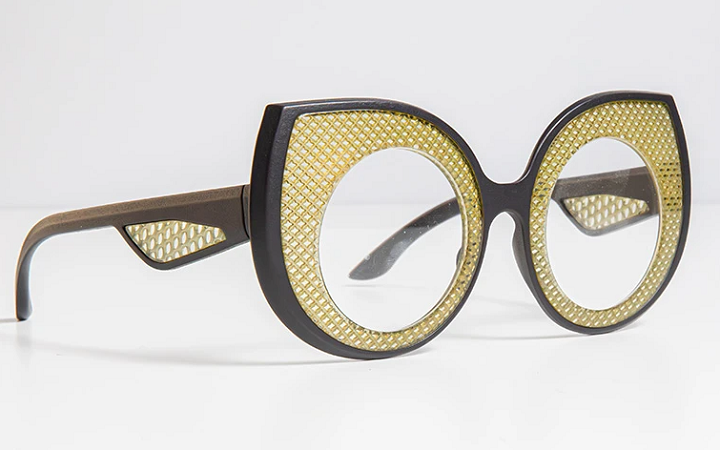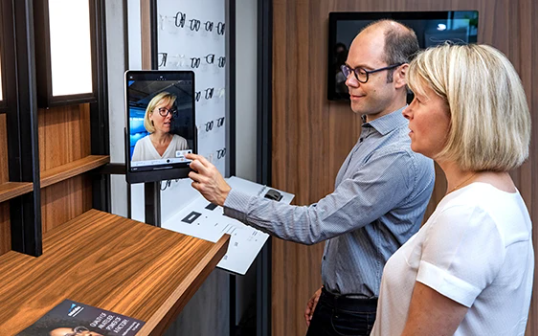Way back in 2017, Fried Vancraen, CEO of Materialise, said he could foresee “a growing amount of meaningful applications” for 3D printing, which included customized eyewear. The Belgium-based 3D printing pioneer counts 3D printed eyewear as one its main applications, and has worked on innovations such as personalized virtual eyewear shopping, smart eyewear, and eco-friendly frames over the years. At the recent SILMO PARIS optical fair, the company introduced its latest offering: 3D printed eyewear with a translucent material, which definitely, as Alireza Parandian, Head of Global Business Strategy, Wearables at Materialise says, “opens up a realm of exhilarating design possibilities for eyewear designers.”
“In the past decade, 3D printing has introduced a new level of freedom that offers designers unlimited creativity to craft intricate and customized frames,” Parandian continued. “Moving forward, the introduction of translucent materials to the 3D printing palette will bring a new dimension to eyewear aesthetics. These materials, with their ethereal qualities, transform eyeglass frames into works of art, offering a unique interplay of complexity and depth.”
In 2022, the global eyewear market size accounted for $169.1 billion, and is estimated to reach $370 billion by 2032, growing at a CAGR of 8.2%. Additionally, industry demand is fueled by fashion-forward designs. The advantages of using AM to make eyewear are numerous, including more sustainability, shorter development cycles, faster routes to market, and more creativity, which leads to those trendy looks. Because of the design freedom that 3D printing offers, designers can experiment with textures, as well as complex structures and shapes, that can’t be achieved with conventional manufacturing. So adoption of the technology in the eyewear industry has been far-reaching.
But, there’s one thing 3D printing hasn’t been able to improve when it comes to eyewear, and that’s the translucent aesthetics you get from typical acetate frames. Materialise spent five years working on trials with over 50 different materials against what it called “the gold standard of established eyewear materials,” testing impact resistance, thermal resilience, and biocompatibility. Finally, the company had a breakthrough, and its new translucent material will enable more “visually compelling collections” to meet consumer demand and move past the design constraints of acetate.
With this new capability, Materialise encourages designers to test out new textures and gradients, interesting shapes, and lightweight structures, in order to improve both style and vision for eyeglasses.
In addition to its translucent material for frames, Materialise showcased another innovative solution at SILMO Paris: its Eyewear Fitting Suite, which can enable the shift from online shopping that became so much more prevalent during the pandemic back to personalized, in-store experiences.
“Today’s customers crave personalization, and with 3D printing, the possibilities are endless. Our Custom Fit Eyewear Suite lets you take personalization one step further and provide a truly unique customer experience. The Suite creates an anatomically exact scan of the face, making it possible to customize frames according to the customer’s features or preferences,” Materialise states on its website.
Consumers who wear glasses want customized products and purchase experiences, and because prescription eyewear accounts for about 63% of the global eyewear market, opticians and retailers who offer that personalization in their products and services definitely stand out from the crowd. Using the Materialise Eyewear Fitting Suite, opticians can build an exact 3D digital model by taking a detailed scan of a customer’s face. The app can be pre-loaded with a retailer’s eyewear collections, along with those of collaborating brands, and together, the optician and customer can visit the platform to choose the perfect, custom-fit frame, looking at a variety of sizes, styles, colors, and shapes.
“AI and other virtual CX tools are increasingly commonplace online. But not in-store. And that’s still where so many customers are heading to get that one-to-one professional support,” Parandian said. “However, around 1 in 4 customers who enter a shop looking to purchase new eyewear abandon their search because they are either overwhelmed by choice or can’t find the exact frame to suit their facial features. Our Eyewear Fitting Suite gives customers a better understanding of which frames perfectly match their specific face size, contours, and features and creates a new in-store shopping experience in search of the perfect frame.”
As a lifelong eyeglasses wearer, I definitely stress when I have to pick out a new pair of glasses—it’s tough to see how they look on your face if you’re shopping online, and if you’re actually in a store, the frames usually have big price stickers on them. So the Eyewear Fitting Suite seems like a fantastic idea.
Additionally, Materialise’s platform gives retailers the option to offer customers an “omnichannel purchasing journey,” while also keeping a digital inventory of frames for on-demand 3D printing. This lowers expensive stock risk, and also supports more sustainable operations with a reduction of potential wasted frames. The frames are 3D printed at the company’s dedicated eyewear production facility, which is the largest of its kind in all of Europe, so opticians can have their focus completely on the customer to offer that coveted customized experience.
(Images courtesy of Materialise)
Subscribe to Our Email Newsletter
Stay up-to-date on all the latest news from the 3D printing industry and receive information and offers from third party vendors.
You May Also Like
Further Understanding of 3D Printing Design at ADDITIV Design World
ADDITIV is back once again! This time, the virtual platform for additive manufacturing will be holding the first-ever edition of ADDITIV Design World on May 23rd from 9:00 AM –...
3D Printer Maker EVO-tech Reborn as NEVO3D — Once More With Feeling
EVO-tech was a 3D printing service and original equipment manufacturer established in 2013 and based in Schörfling am Attersee, Austria. The company produced high-quality material extrusion systems featuring linear bearings,...
3D Systems Brings 3D Printed PEEK Cranial Implant to the U.S. with FDA Clearance
For more than 10 years, 3D Systems (NYSE:DDD) has worked hand-in-hand with surgeons to plan over 150,000 patient-specific cases, and develop more than two million instruments and implants from its...
CDFAM Returns to Berlin for Second Annual Symposium
The second CDFAM Computational Design Symposium is scheduled for May 7-8, 2024, in Berlin, and will convene leading experts in computational design across all scales. Building upon the first event...

































